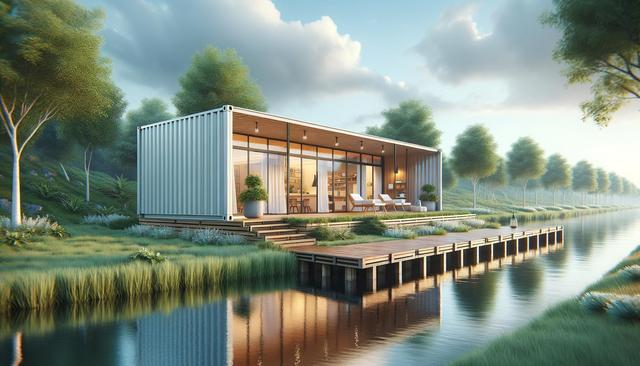Understanding Shipping Containers: Structure, Durability, and Purpose
Shipping containers were originally engineered to transport goods across oceans, railways, and highways. Made from high-strength corten steel, they are designed to withstand harsh weather, rough handling, and long-term wear. These characteristics make them ideal candidates for repurposing into functional spaces. The adaptability of containers has led to a growing trend in using them for far more than logistics. Today, they are being converted into homes, offices, pop-up shops, and even schools. Their structural integrity, uniform shape, and stackable design allow for creative and modular architecture that’s both functional and visually striking.
The most commonly used types of shipping containers include:
- Standard Dry Containers – used for general storage and transport
- High Cube Containers – extra height for taller items or multi-level builds
- Refrigerated Containers – for transporting temperature-sensitive goods
- Open Top and Flat Rack Containers – suitable for oversized or bulky cargo
These types of shipping containers offer a flexible foundation for both traditional and non-traditional applications.
Innovative Living and Working Spaces
One of the most exciting developments in recent years is the transformation of shipping containers into innovative living and working environments. Container homes are gaining popularity worldwide for their affordability, speed of construction, and modular nature. By combining multiple units, homeowners and architects can design multi-room dwellings that rival traditional housing in both comfort and style. Additionally, container offices and co-working spaces are now being used in urban areas where space is limited and expensive.
These applications highlight the increasing number of innovative uses for shipping containers:
- Temporary or permanent housing solutions
- Mobile clinics and disaster relief shelters
- Retail kiosks and food stalls
- Pop-up art galleries and studios
What makes these spaces even more attractive is their mobility and adaptability. With proper insulation, ventilation, and interior design, containers can be transformed into highly functional and aesthetic spaces.
Environmental and Economic Benefits
Repurposing shipping containers supports environmentally friendly solutions by reducing waste and conserving resources. Instead of letting decommissioned containers rust away in storage yards, they can be given a second life as habitable or commercial spaces. This reuse minimizes the need for new construction materials, which helps reduce carbon emissions associated with traditional building methods.
In addition to environmental advantages, there are also benefits for businesses. Companies can save money on construction and setup costs by opting for container-based structures. These units also provide faster deployment, making them ideal for temporary setups or rapidly growing startups. Some key business benefits include:
- Lower upfront construction costs
- Shorter project timelines
- Ease of transport and relocation
- Scalable and modular design options
Whether used as retail spaces, offices, or storage units, containers offer a cost-effective and sustainable solution for modern business needs.
Adaptability Across Industries
Shipping containers are not limited to just residential or small business use. In fact, various industries are leveraging their versatility for unique applications. In the education sector, containers are being converted into classrooms and libraries, especially in remote or underserved areas. The healthcare industry uses them for mobile clinics, vaccination centers, and even operating theaters in emergency zones.
Other sectors utilizing container structures include:
- Hospitality – modular hotels and guest cabins
- Agriculture – hydroponic farms and storage units
- Construction – on-site offices and equipment storage
- Events – portable stages, ticket booths, and VIP lounges
The adaptability of these units makes them a practical choice for a wide range of functions. Their ability to be modified to fit specific requirements enhances their value and underscores their potential in both public and private sector projects.
The Evolving Future of Shipping Containers
Looking ahead, the future of shipping containers appears increasingly integrated into sustainable urban planning and architectural innovation. As cities seek more eco-conscious and space-saving solutions, container-based construction is expected to grow. Architects and designers continue to push the boundaries of what’s possible, developing smart container homes equipped with solar panels, green roofs, and energy-efficient systems.
Technological advancements also play a role in expanding possibilities. With modern design software, engineers can create intricate container-based projects faster and more accurately. More importantly, regulatory bodies are beginning to adapt building codes to accommodate container architecture, which could further boost adoption rates.
As demand grows for flexible, fast, and sustainable construction methods, shipping containers are becoming a key player in the future of urban development. Their resilience, affordability, and adaptability make them a practical choice for a wide array of uses, from personal homes to commercial complexes.
Conclusion: A Practical Choice with Lasting Value
Shipping containers offer a compelling solution for both individuals and businesses seeking creative, cost-effective, and sustainable alternatives to traditional construction. By understanding the different types of shipping containers and exploring their many applications, it’s clear how these once-single-use structures are being transformed into dynamic assets. Whether you’re interested in innovative uses for shipping containers, exploring benefits for businesses, or seeking environmentally friendly solutions, the potential is vast. As the future of shipping containers continues to evolve, they are likely to remain a cornerstone of modern and forward-thinking design strategies.




Leave a Reply